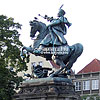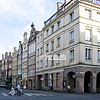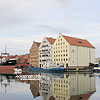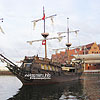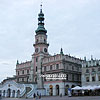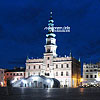Poland
Poland is situated in the eastern part of the Central European lowland and it is a lowland country. Average altitude is 173 m above sea level. Almost 91% of the country's surface is lower than 300 m above sea level. The bigger part of the territory is mainly occupied with broad lowlands, vivid mosaics of fields, deciduous and coniferous forests, meadows and small lakes. Despite the majority of lowlands, the landscape is variegated, it is characterised by ridged structure of the geographical regions and rich relief.
On plains in the east of Poland there are wide water areas. Narew river is the most unique river in Europe, it looks like an untwisted plait, overflowing on the outskirts of Białystok and then disappearing in the narrow channels, just like Amazon river. Biebrza river, near Goniądz, turns the outskirts into huge bogs.
Northern Poland is a sandy area. The sand is fine and pure, and it is even fairer here than it is in the Mediterranean. The broad Baltic beaches stretch along the bluffs, spits and peninsulas, then they hide in the dunes. In Słowiński National Park on the Baltic coast there are moving dunes up to 30 m high and shallow seaside lakes. The sand that is constantly moving buries the seaside forests and bogs, even human settlements, but at the same time it uncovers terrains it absorbed before.
The Baltic coast is separated from the rest of the territory of Poland by the belt of lakes. There are Drawskie, Kaszubskie, Mazurskie and Suwalskie lakeside regions. The entire number of lakes is over 9 thousand, and most of them appeared due to glacier activity. It is in Mazurskie lakeside region that the biggest lakes in Poland are situated — Śniardwy and Mamry. Śniardwy is the biggest lake (113 km2), while the deepest one is Hańcza (108.5 m). The last icing moved back not so long ago — 10 — 12 thousand years ago, that is why relief of the area is accurate. The best model of the glacier activity is the area of Suwalski landscape park. Some parts of the landscape resemble pyramids, terraces and hanging valleys.
Southern Poland is hidden by the range of young mountains, such as the Carpathians and the Tatras. The Tatras are the highest range of the Polish Carpathians. Zakopane town, which is characterised by highland features, lies at the mountain foot. In the Tatras there are caves, cavities, highland lakes and waterfalls, which were formed after the glacier's activity. There are also time-honoured mountains in Poland, they exist over 4.5 billion years from the beginning of the Earth's history. They are called the Sudety. Several times they were ruined by erosion, then they rose again and they were even exposed to the volcano later. In the Sudety there are the Table Mountains — the unique mountains in Europe, since they are not folded, but slab, with parallel and plain bedding of sandstone layers.
For most foreigners, Poland is first of all a land of verdure and natural landscapes. Woods occupy big part of the territory (almost 28%), and these are mainly coniferous woods. In contrast to many European countries, they are open to the public. In particular, the Puszcza Białowieska is entered to the list of the UNESCO world cultural and natural heritage: the forest is the last preserved area with dedicious woods, that covered the whole European continent long ago. It is one of the most ecologically clean areas in the country. The Biebrza bogs are the best kept peat bogs in Europe. The natural environment was also preserved on the mountainous terrains, from Sudets to the most densely populated Bieszczady.
Polish flora numbers over 2 thousand species. Many relic plants have been preserved there, those which were anciently popular in Europe, but have become endangered species now. This is the ostróżka tatrzańska (Delphinium oxysepalum, Ranunculaceae, a relic from the Tertiary period), the różanecznik żółty (Rhododendronflavum, azalea, a steppe relic) and the dwarf birch.
Many kinds of animals living in natural conditions in Poland do not occur anywhere else. The first regulations, which guaranteed wildlife conservation, in particular such rare animals as the beaver, aurochs and bison, were issued here as early as in the ХІ century. With great success, the population of the bison (the biggest European mammal) was revived in Puszcza Białowieska. The beaver has been saved likewise: 20 years ago there were just about one thousand animals, whereas nowadays there are 25 thousand of them. In mountainous forests wolves, bears and lynxes live — a number of them live in Puszcza Kampinoska — the national park near Warsaw. Storks also love Poland very much: 25% of the world population of white storks nest between the Odra and Buh rivers; ornithologists count over 40 thousand birds in Poland. The Biebrza river flood plains belong to the most interesting nature terrains in Europe, with 253 species of birds that live there. Kilometres long bogs and lakes are shelters for many species, which are rare in Europe. The Biebrza bogs also belong to the terrains least modified by human activity, in the European continent.
By the size of reserves, Poland is one of the first countries in the continent. Plants and animals are protected in 22 national parks and 1200 nature reserves. Protected areas occupy over 100 thousand km2, which is over 30% of the total area of the country. At the same time, national parks and terrains with attractive scenery are open to the public.
Poland is situated in the temperate zone. Most part of the year, the weather is quite similar to the weather in Brussels and Berlin — variable, with changes due to particular season. The warmest regions in Poland are the southern and western areas of the country (Wroclaw, Krakow), where climate is formed by the warmest air from the western part of the continent. In the north and west of Poland the climate is moderately maritime, with mild winters and humid summers, in the east the climate is continental, in winter there are severe frosts, but in summer it is dry and hot there. The north-east of Poland is the coldest (Mazurski lakes, Suwałki and Białystok), being frequently under the influence of the Arctic air from Russia.
While the best time to have a journey is in spring and summer, warm and dry September and October give an opportunity to admire the Golden autumn in Poland. It is the best period to enjoy the magnificent views of the woody mountain slopes in southern Poland and leaf forests in the lowlands.
Administrative division of the country is as follows: 16 provinces, 314 districts and 2478 gminas (boards). It was in 1999 that the historic three-level administrative division was restored.The provinces in Poland:
- Warmian-Masurian province (Województwo Warmińsko-Mazurskie), Olsztyn
- Greater Poland province (Województwo Wielkopolskie), Poznań
- West Pomeranian province (Województwo Zachodniopomorskie), Szczecin
- Kuyavian-Pomeranian province (Województwo Kujawsko-Pomorskie), Bydgoszcz
- Łódź province (Województwo Łódzkie), Łódź
- Lublin province (Województwo Lubelskie), Lublin
- Lubusz province (Województwo Lubuskie), Gorzów Wielkopolski
- Masovian province (Województwo Mazowieckie), Warsaw
- Lesser Poland province (Województwo Małopolskie), Krakow
- Lower Silesian province (Województwo Dolnośląskie), Wroclaw
- Opole province (Województwo Opolskie), Opole
- Subcarpathian province (Województwo Podkarpackie), with the centre in Rzeszów town
- Podlaskie province (Województwo Podlaskie), Białystok
- Pomeranian province (Województwo Pomorskie), Gdansk
- Holy Cross province (Województwo Świętokrzyskie), Kielce
- Silesian province (Województwo Śląskie), Katowice
The biggest cities:
- Warsaw (Warszawa), the capital - 1 676.0 thousand, agglomeration 2 400.0 thousand
- Lodz (Łódź) — 803.4 thousand
- Krakow (Kraków) — 740.0 thousand
- Wroclaw (Wrocław) — 637.2 thousand
- Poznan (Poznań) — 577.5 thousand
- Gdansk (Gdańsk) — 458.4 thousand
- Szczecin (Szczecin) — 416.7 thousand
- Bydgoszcz (Bydgoszcz) — 386.0 thousand
- Lublin (Lublin) — 356.5 thousand
- Katowice (Katowice) — 344.8 thousand

 Ukraine
Ukraine Poland
Poland Slovakia
Slovakia
 Українською
Українською